I'm not an astrophysicist nor a relativity theorist, but this makes absolutely no sense.. The article writes,
When we say that the Earth is 4.5 billion years old, technically we mean 4.5 billion years is the maximum amount of relative time any thing could have experienced since the Earth was formed.
If by "Earth is 4.5 billion years old" it means the time lapse as experienced on earth -- in other words, as measured by a clock on earth, then the clock is in the rest frame and therefore measures the shortest possible time duration among all clocks in other (moving) inertial frames, not "the maximum amount of relative time" (special relativity). I think the author is confusing this with the twin paradox where the traveling twin ages slower. The talk of
There is a maximum amount of relative time that can be experienced between any two points in time (no time dilation). There is a maximum relative distance between any two points in space (no length contraction)
is also troublesome -- what is even "two points in time (no time dilation)"? One should instead be talking about two events and their space-time coordinates
